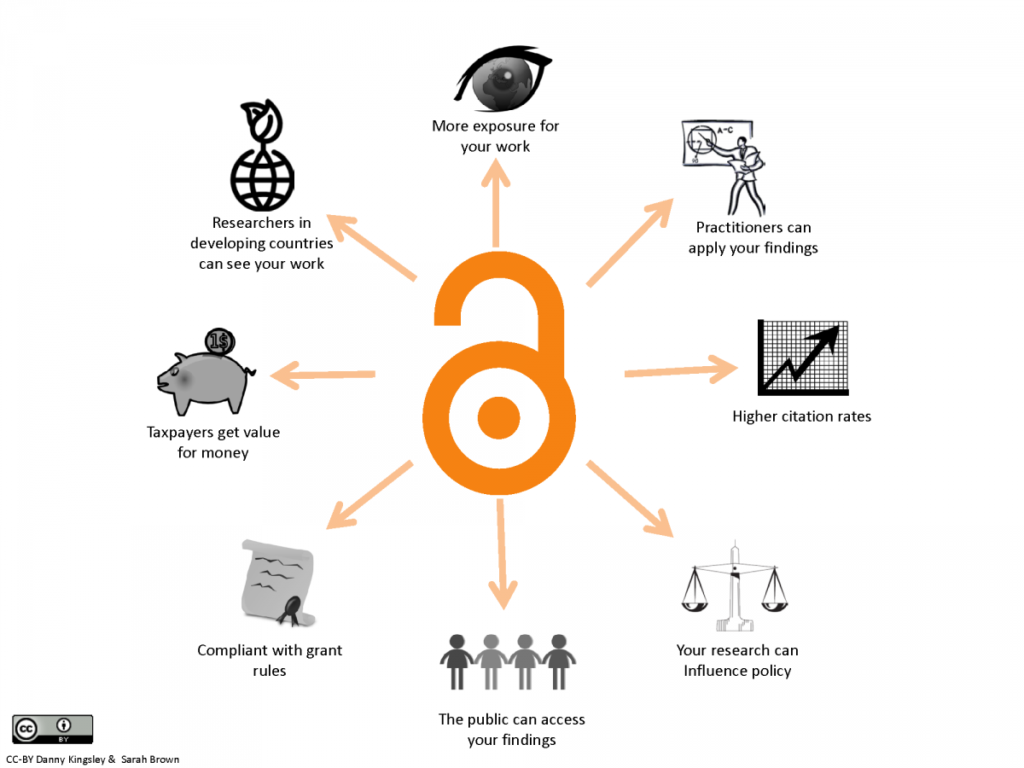What is Open Access?
These days, the traditional model of scientific communication is undergoing radical change. The rise of the internet and the pricing crisis afflicting academic journals (the result of the aggressively profit-oriented pricing policies of major publishing houses) have together lead to the rise of the Open Access movement, which has steadily increased in importance and has emerged as a viable alternative model of scientific communication. The main goal of the Open Access movement is to make scientific publications freely available to all readers.
In other words, Open Access means the online, digital, and free-of-charge publication of research results (publications and datasets). It also entails the free and legal re-use of publications: open access documents can be freely downloaded, copied, share and printed – the only requirement is that the original author should be acknowledged and cited.
Open Access enhances the wider dissemination of scientific results: this increases the profile and prestige of universities and research institutes and the citation counts of individual researchers. Maybe more importantly, it also ensures that new scientific findings (which are in most cases the result of publicly funded research) are available free of charge to the research community and also to the wider public.
Benefits of Open Access

For researchers:
- Increased visibility and prestige for the researcher.
- Increased visibility and impact of research results, higher citation numbers.
- Numerous grant-giving authorities oblige the recipients of grants to publish their results in open access format.
For universities and research institutes:
- Supporting open access expresses the commitment of the institution to open access publishing, i.e., a commitment to make publicly funded research freely accessible to the wider public.
- By indexing, storing, preserving, circulating and actively disseminating the research results of their faculty, universities improve their scientific standing as an institution.
- The repository of Corvinus University can be found here: Corvinus Research Archive
For society:
- Publicly funded research results become freely accessible.
- New research directions and results receive a wider publicity.
- Research institutions become more active in communicating their results to the public.
Types of Open Access
GREEN
Green Open Access is self-archiving by the author. The author makes some version of the publication freely available by way of depositing it in an institutional or a discipline-based repository, or by uploading it to the author’s own homepage.
Such self-archiving always take place in compliance with the contract signed between the author and the publisher. Publishers typically allow some kind of self-archiving (Green OA). The final published version of the manuscript usually cannot be self-archived, however, preprint or postprint versions in most cases can be, sometimes with a certain predefined time lag (embargo period). The embargo period is typically one year from the date of publishing. Some publishers require a shorter embargo period and some other publishers do not require an embargo period at all.
- Preprint: the version submitted to the journal (a version prior to peer review and acceptance)
- Postprint: the version which has been accepted for publication, it includes revisions made by the authors in response to the peer review process. A postprint differs from the final published version in that it had not been subject to copyediting by the publisher.
- Embargo: a temporary limit on free access. Some journals require that the publication be only made freely available after a certain amount of time (the embargo period) has passed since publishing. Embargo lengths vary, the most typical is one year.
Authors should acquaint themselves with the archiving policies of publishers. The website SHERPA/RoMEO provides an overview of the policies of the major publishers. Information can also be found on the homepages of the individual publishers.
GOLD
Gold Open Access is the publication of scientific articles in open access journals. (I.e., journals which provide free access to all of their articles.) In this case, the article will be accessible on the journal’s webpage. Some publishers require that the authors of an accepted manuscript pay an article processing charge (APC) before publication.
APC (Article Processing Charge): At certain open access publications, publishing costs need to be covered by the published authors in the form of an article processing charge. (In practice, it is typically the university or research institute with which the author is affiliated that pays the charge.)
PLATINUM / DIAMOND
Diamond Open Access is the publication of scientific articles in open access journals which do not charge an APC.
HYBRID
Hybrid access covers the practice of certain traditional, subscription-based non-open-access journals, where it is possible for authors to pay in order for their particular article to be made freely available. This means, however, that while that particular article becomes freely available, all the other articles in the same issue continue to be available only to subscribers. Hybrid journals in effect collect both traditional subscription fees and also payments from authors who wish to make their articles freely available.